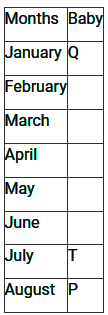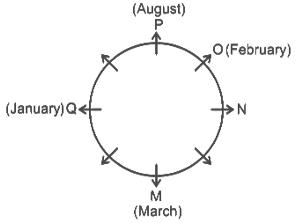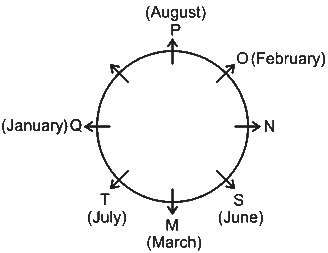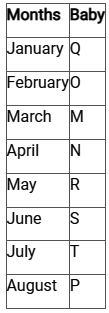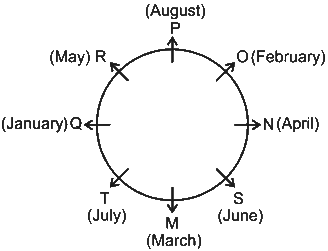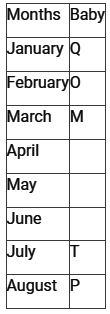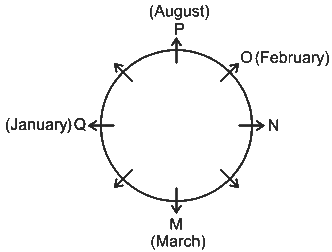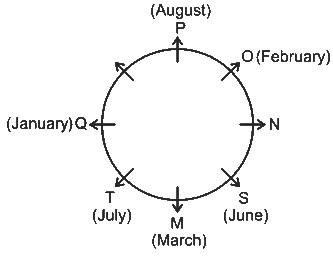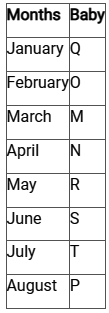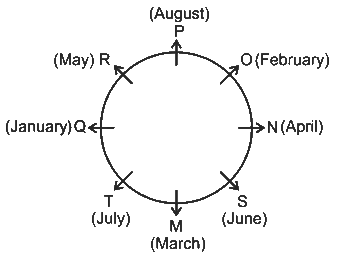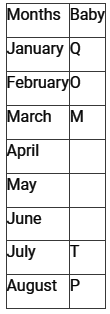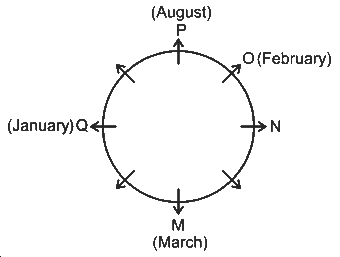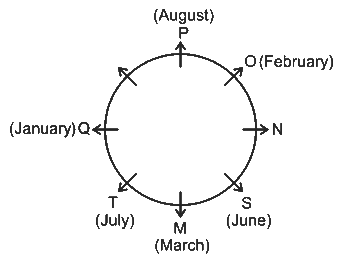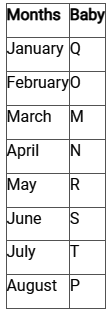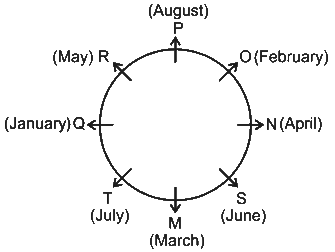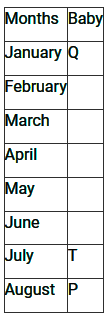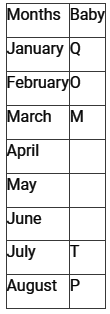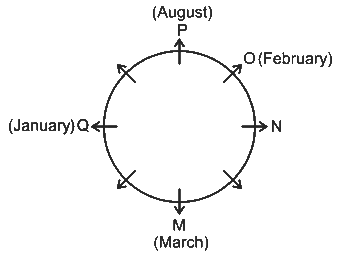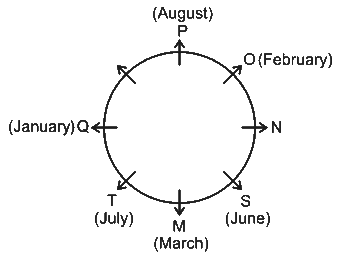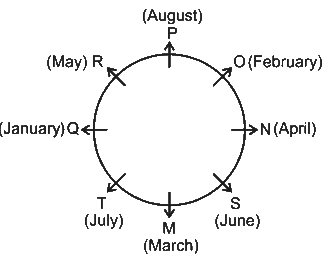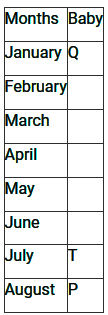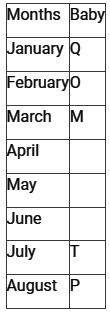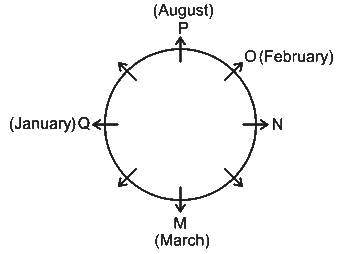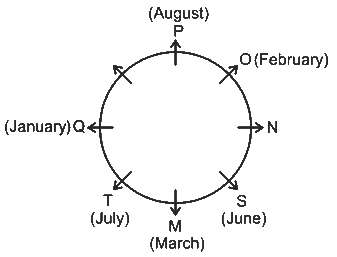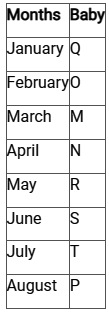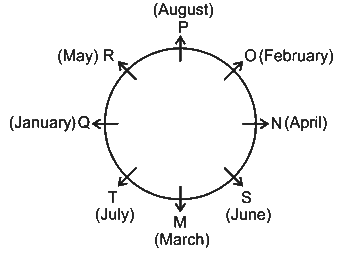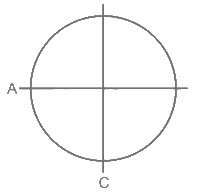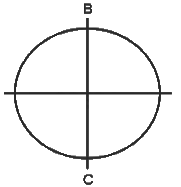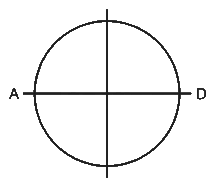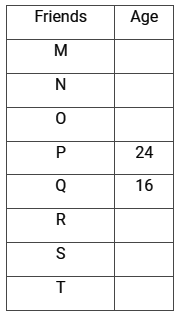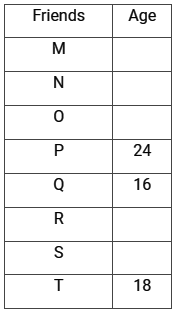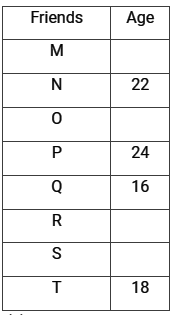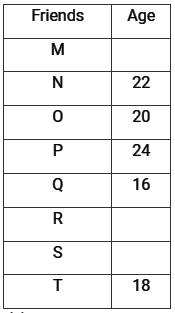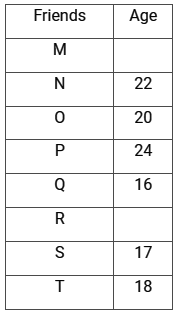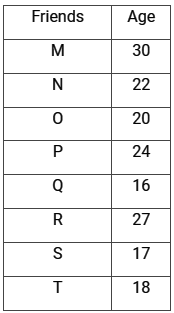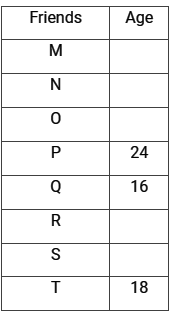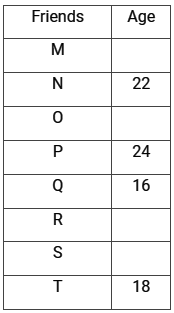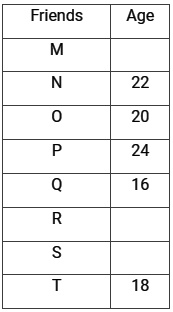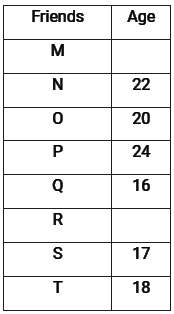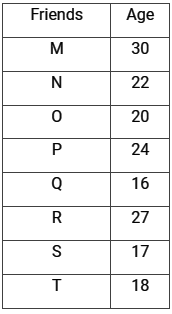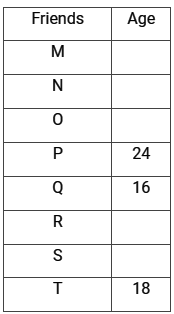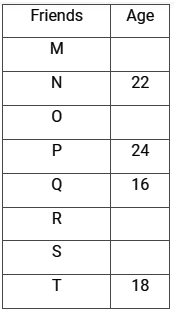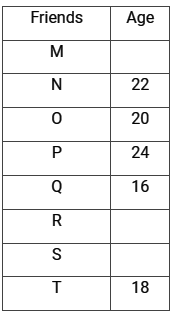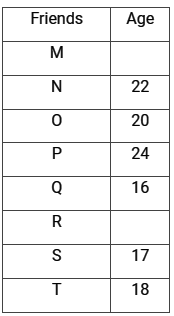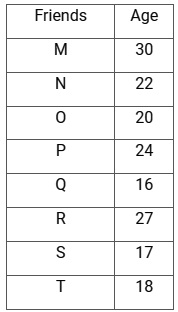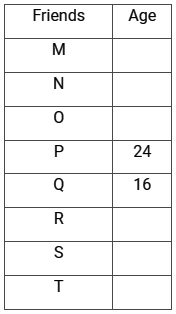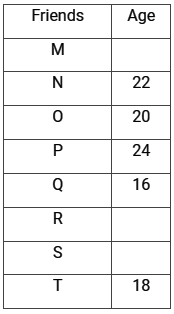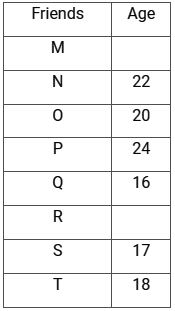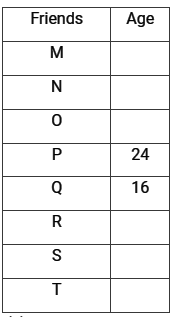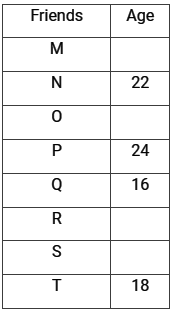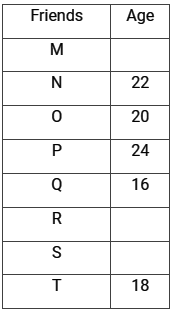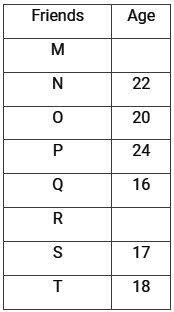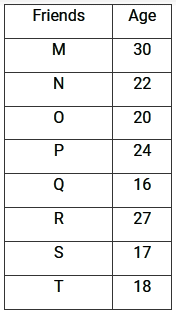IBPS SO Prelims Mock Test - 1 - Banking Exams MCQ
30 Questions MCQ Test - IBPS SO Prelims Mock Test - 1
Directions: Study the following information carefully and answer the questions given below:
In a play school there are eight babies sitting around a circular table, facing outside from the centre. Each of them was born at the starting of a different month of a year starting from January. Each of the seats occupied by one baby.
P is sitting second to the left of N. O is sitting third to the left of M. O and M were born before April. Only the one who born in June is sitting exactly between M and N. Q, who is the eldest, is not an immediate neighbour of M or P. T is older than only P. T is sitting second to the right of S. S is not an immediate neighbour of Q. M is younger than O. N was born before R.
Q. Who is sitting third to the left of R?
Directions: Study the following information carefully and answer the questions given below:
In a play school there are eight babies sitting around a circular table, facing outside from the centre. Each of them was born at the starting of a different month of a year starting from January. Each of the seats occupied by one baby.
P is sitting second to the left of N. O is sitting third to the left of M. O and M were born before April. Only the one who born in June is sitting exactly between M and N. Q, who is the eldest, is not an immediate neighbour of M or P. T is older than only P. T is sitting second to the right of S. S is not an immediate neighbour of Q. M is younger than O. N was born before R.
Q. Who sits exactly opposite the one who was born in April?
Directions: Study the following information carefully and answer the questions given below:
In a play school there are eight babies sitting around a circular table, facing outside from the centre. Each of them was born at the starting of a different month of a year starting from January. Each of the seats occupied by one baby.
P is sitting second to the left of N. O is sitting third to the left of M. O and M were born before April. Only the one who born in June is sitting exactly between M and N. Q, who is the eldest, is not an immediate neighbour of M or P. T is older than only P. T is sitting second to the right of S. S is not an immediate neighbour of Q. M is younger than O. N was born before R.
Q. Which of the following statements is true regarding N?
Directions: Study the following information carefully and answer the questions given below:
In a play school there are eight babies sitting around a circular table, facing outside from the centre. Each of them was born at the starting of a different month of a year starting from January. Each of the seats occupied by one baby.
P is sitting second to the left of N. O is sitting third to the left of M. O and M were born before April. Only the one who born in June is sitting exactly between M and N. Q, who is the eldest, is not an immediate neighbour of M or P. T is older than only P. T is sitting second to the right of S. S is not an immediate neighbour of Q. M is younger than O. N was born before R.
Q. In which month was T born?
Directions: Study the following information carefully and answer the questions given below:
In a play school there are eight babies sitting around a circular table, facing outside from the centre. Each of them was born at the starting of a different month of a year starting from January. Each of the seats occupied by one baby.
P is sitting second to the left of N. O is sitting third to the left of M. O and M were born before April. Only the one who born in June is sitting exactly between M and N. Q, who is the eldest, is not an immediate neighbour of M or P. T is older than only P. T is sitting second to the right of S. S is not an immediate neighbour of Q. M is younger than O. N was born before R.
Q. Who is the second oldest in the group?
Directions: Study the following information to answer the given question.
Seven friends T, U, V, W, X, Y and Z are sitting in a straight line facing north. W sits fifth to the right of T. W does not sit at any of the extreme ends. Two people sit between Z and X. Y sits third to the left of U. Y sits exactly in the middle. Z is not an immediate neighbour of Y.
Q. If all the seven friends are made to sit alphabetically from left to right, positions of how many will remain unchanged?
Directions: Study the following information to answer the given question.
Seven friends T, U, V, W, X, Y and Z are sitting in a straight line facing north. W sits fifth to the right of T. W does not sit at any of the extreme ends. Two people sit between Z and X. Y sits third to the left of U. Y sits exactly in the middle. Z is not an immediate neighbour of Y.
Q. Who is second to the right of T?
Directions: Study the following information to answer the given question.
Seven friends T, U, V, W, X, Y and Z are sitting in a straight line facing north. W sits fifth to the right of T. W does not sit at any of the extreme ends. Two people sit between Z and X. Y sits third to the left of U. Y sits exactly in the middle. Z is not an immediate neighbour of Y.
Q. Who among the following are at the extreme ends of the line?
Directions: Study the following information to answer the given question.
Seven friends T, U, V, W, X, Y and Z are sitting in a straight line facing north. W sits fifth to the right of T. W does not sit at any of the extreme ends. Two people sit between Z and X. Y sits third to the left of U. Y sits exactly in the middle. Z is not an immediate neighbour of Y.
Q. Four of the following five are alike in a certain way based on their seating positions in the above line and so form a group. Which of the following pairs does not belong to the group?
Directions: Study the following information to answer the given question.
Seven friends T, U, V, W, X, Y and Z are sitting in a straight line facing north. W sits fifth to the right of T. W does not sit at any of the extreme ends. Two people sit between Z and X. Y sits third to the left of U. Y sits exactly in the middle. Z is not an immediate neighbour of Y.
Q. What is Z's position with respect to W?
Directions: In the following question, a statement is followed by two assumptions. You have to decide which of the given assumptions is/are implicit in the statement.
Statement:
Consumption per se is growing.
Assumptions:
I. Inflationary trends will be observed in consumer goods in the long run.
II. Strong economy is creating a wider affluence.
Directions: In the question below are given two statements followed by two conclusions numbered I and II. You must take the given statements to be true even if they seem to be at variance with commonly known facts. Read all the conclusions and then decide which of the given conclusions logically follow (s) from the given statements disregarding commonly known facts.
Statements:
Some colleges are schools.
No school is a coaching institute.
Conclusions:
I. All colleges can be coaching institutes.
II. All school can be coaching institutes.
Directions: Read the short passage given below and answer the question that follows.
Organisations are often defined as groups of people who come together to pursue a common goal. But more often than not, goals diverge as much as they converge, making the rationality of the overall organisation no more than an elusive ideal. Beneath the collective irrationality, however, organisations are often operating in a way that is eminently rational from the standpoint of the individuals, groups and coalitions directly involved.
Q. Which of the following statements can be inferred from the given passage?
Direction: The following question consist of three statements numbered I, II and III. Decide if data given in the statements are sufficient to answer the question below.
Four members A, B, C and D are sitting around a round table at an equal distance facing inside.
Q. Who is sitting immediate right of B?
I. A is immediate left to C.
II. B is sitting opposite to C.
III. D is not an immediate neighbour of A.
Directions: Read the following statement carefully and answer the question.
The Punjab and Haryana High Court has now restricted timings for bursting of crackers on Gurpurab for three hours — 6.30 to 9.30 p.m. — in the two States and Chandigarh.
Q. Which of the following is not a possible reason for the order?
In the following question, two statements are given followed by two conclusions. Assuming the given statements to be true, even if they seem to be at variance from commonly known facts, read all the conclusions and then decide which of the given conclusions logically follows the given statements.
Statements:
I. Some exams are tough.
II. At least some subjects are easy.
Conclusions:
I. No subject is tough.
II. No exam is easy.
Choose the correct option to complete the following series:
LWP, NZQ, PCR, ___, TIT
Directions: In making decisions about important questions, it is desirable to be able to distinguish between ‘strong’ arguments and ‘weak’ arguments. ‘Strong’ arguments are those, which are both important and directly related to the question. ‘Weak’ arguments are those, which are of minor importance and also may not be directly related to the question or may be related to a trivial aspect of the question. The question below is followed by two arguments numbered I and II. You have to decide which of the arguments a ‘strong’ argument is and which a ‘weak’ argument is.
Statement: Should children be exposed to violent video games?
Arguments:
I. Yes. Children can distract themselves from the stress of studies.
II. No. It makes them over aggressive and arrogant.
A man walks 1 km towards east and then he turns towards south and walks 5 km. He again turns towards east and walks 2 km. Finally, he turns towards north and walks 9 km. How far is he from his starting point?
Direction: Read the instructions carefully and answer the question below.
Ten members of a family Adarsh, Binod, Chanchal, Dhruv, Emran, Farah, Ganesh, Harsh, Ikshul and Jatin differ in their ages. A list was prepared in which the ages of all the members were arranged in descending order.
Adarsh is the eldest while Binod is the youngest. Jatin is older than five people. Chanchal is younger than Adarsh but older than Jatin. Ganesh is older than seven people. Dhruv is only older than Binod. Harsh is older than Ikshul, Farah, and Emran but younger than Chanchal. Farah is older than Emran but younger than Ikshul.
Q. Who is the second youngest person in the list?
Directions: Study the following information carefully and answer the questions given below.
Eight friends - M, N, O, P, Q, R, S, and T are members of the same society - Malik Enclave. They all belong to different age group - 16, 17, 18, 20, 22, 24, 27 and 30. T is 18 years old. P is 4 years elder than the age of O. S was born between Q and T. Age of N is 10 more than the half the age of P. Age of R is 10 years more than the age of S. Age of P is thrice the half of the age of Q who is 16 years old.
Q. Which of the following statement is correct?
Directions: Study the following information carefully and answer the questions given below.
Eight friends - M, N, O, P, Q, R, S, and T are members of the same society - Malik Enclave. They all belong to different age group - 16, 17, 18, 20, 22, 24, 27 and 30. T is 18 years old. P is 4 years elder than the age of O. S was born between Q and T. Age of N is 10 more than the half the age of P. Age of R is 10 years more than the age of S. Age of P is thrice the half of the age of Q who is 16 years old.
Q. Who is the youngest member of the society among these eight friends?
Directions: Study the following information carefully and answer the questions given below.
Eight friends - M, N, O, P, Q, R, S, and T are members of the same society - Malik Enclave. They all belong to different age group - 16, 17, 18, 20, 22, 24, 27 and 30. T is 18 years old. P is 4 years elder than the age of O. S was born between Q and T. Age of N is 10 more than the half the age of P. Age of R is 10 years more than the age of S. Age of P is thrice the half of the age of Q who is 16 years old.
Q. Who is 24 years old?
Directions: Study the following information carefully and answer the questions given below.
Eight friends - M, N, O, P, Q, R, S, and T are members of the same society - Malik Enclave. They all belong to different age group - 16, 17, 18, 20, 22, 24, 27 and 30. T is 18 years old. P is 4 years elder than the age of O. S was born between Q and T. Age of N is 10 more than the half the age of P. Age of R is 10 years more than the age of S. Age of P is thrice the half of the age of Q who is 16 years old.
Q. Who is eldest among all?
Directions: Study the following information carefully and answer the questions given below.
Eight friends - M, N, O, P, Q, R, S, and T are members of the same society - Malik Enclave. They all belong to different age group - 16, 17, 18, 20, 22, 24, 27 and 30. T is 18 years old. P is 4 years elder than the age of O. S was born between Q and T. Age of N is 10 more than the half the age of P. Age of R is 10 years more than the age of S. Age of P is thrice the half of the age of Q who is 16 years old.
Q. Who is 5 years elder than N?
Directions: Follow the instructions given below.
When a word and number rearrangement machine is given an input line of words and numbers, it rearranges them following a particular pattern. Given below is an example of input and rearrangement:
Input: rest 76 24 peace today matter 36 first left
Step I: first rest 76 24 peace today matter 36 left
Step II: first left rest 76 24 peace today matter 36
Step III: first left 24 rest 76 peace today matter 36
Step IV: first left 24 matter rest 76 peace today 36
Step V: first left 24 matter peace rest 76 today 36
Step VI: first left 24 matter peace 36 rest 76 today
Step VII: first left 24 matter peace 36 rest today 76
Step VII is the last step of the arrangement.
Now, as per the pattern followed in the above steps, answer the following question based on the input given below:
Input: was beauty 92 37 after sweet quest 11 gift
Q. Which elements occupies the 6th position from the left end in Step V?
Directions: Follow the instructions given below.
When a word and number rearrangement machine is given an input line of words and numbers, it rearranges them following a particular pattern. Given below is an example of input and rearrangement:
Input: rest 76 24 peace today matter 36 first left
Step I: first rest 76 24 peace today matter 36 left
Step II: first left rest 76 24 peace today matter 36
Step III: first left 24 rest 76 peace today matter 36
Step IV: first left 24 matter rest 76 peace today 36
Step V: first left 24 matter peace rest 76 today 36
Step VI: first left 24 matter peace 36 rest 76 today
Step VII: first left 24 matter peace 36 rest today 76
Step VII is the last step of the arrangement.
Now, as per the pattern followed in the above steps, answer the following question based on the input given below:
Input: was beauty 92 37 after sweet quest 11 gift
Q. In which step does "was" occur to the immediate right of gift?
Directions: Follow the instructions given below.
When a word and number rearrangement machine is given an input line of words and numbers, it rearranges them following a particular pattern. Given below is an example of input and rearrangement:
Input: rest 76 24 peace today matter 36 first left
Step I: first rest 76 24 peace today matter 36 left
Step II: first left rest 76 24 peace today matter 36
Step III: first left 24 rest 76 peace today matter 36
Step IV: first left 24 matter rest 76 peace today 36
Step V: first left 24 matter peace rest 76 today 36
Step VI: first left 24 matter peace 36 rest 76 today
Step VII: first left 24 matter peace 36 rest today 76
Step VII is the last step of the arrangement.
Now, as per the pattern followed in the above steps, answer the following question based on the input given below:
Input: was beauty 92 37 after sweet quest 11 gift
Q. The position of "quest" in Step VI is:
Directions: Follow the instructions given below.
When a word and number rearrangement machine is given an input line of words and numbers, it rearranges them following a particular pattern. Given below is an example of input and rearrangement:
Input: rest 76 24 peace today matter 36 first left
Step I: first rest 76 24 peace today matter 36 left
Step II: first left rest 76 24 peace today matter 36
Step III: first left 24 rest 76 peace today matter 36
Step IV: first left 24 matter rest 76 peace today 36
Step V: first left 24 matter peace rest 76 today 36
Step VI: first left 24 matter peace 36 rest 76 today
Step VII: first left 24 matter peace 36 rest today 76
Step VII is the last step of the arrangement.
Now, as per the pattern followed in the above steps, answer the following question based on the input given below:
Input: was beauty 92 37 after sweet quest 11 gift
Output: after beauty 11 was 92 37 sweet quest gift
Q. Which step of the arrangement yields the given output?
Directions: Follow the instructions given below.
When a word and number rearrangement machine is given an input line of words and numbers, it rearranges them following a particular pattern. Given below is an example of input and rearrangement:
Input: rest 76 24 peace today matter 36 first left
Step I: first rest 76 24 peace today matter 36 left
Step II: first left rest 76 24 peace today matter 36
Step III: first left 24 rest 76 peace today matter 36
Step IV: first left 24 matter rest 76 peace today 36
Step V: first left 24 matter peace rest 76 today 36
Step VI: first left 24 matter peace 36 rest 76 today
Step VII: first left 24 matter peace 36 rest today 76
Step VII is the last step of the arrangement.
Now, as per the pattern followed in the above steps, answer the following question based on the input given below:
Input: was beauty 92 37 after sweet quest 11 gift
Q. How many steps are needed to complete the arrangement?


